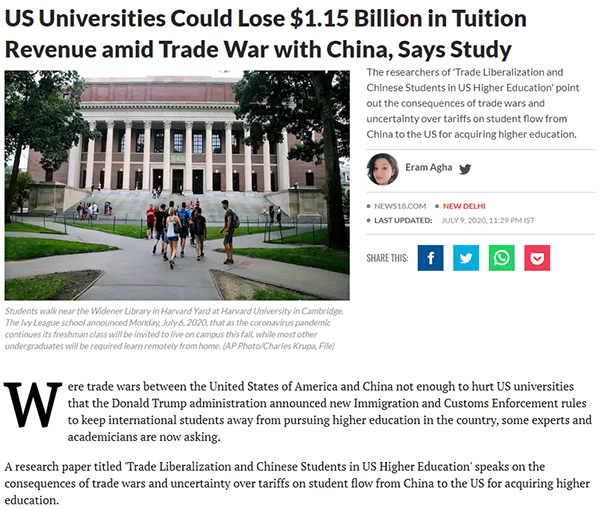
The joint research paper entitled “Trade Liberalization and Chinese Students in US Higher Education” has been largely cited by international media. The research is coauthored by two faculty members from Peking University --- Miaojie Yu (National School of Development) and Mingzhi Xu (Institute of New Structural Economics), along with three international scholars --- Gaurav Khanna (University California, San Diego), Kevin Shih (Queens College, City University of New York) and Ariel Weinberger (George Washington University).
The recent US-China trade tension initiated by the United States has brought huge trade policy uncertainty to the pace of globalization, which has hurt businesses and weighed on the world economy. Previous evidence has revealed that the US-China tension has negatively affected the US consumers’ purchasing power. However, new research from Peking University also shows lesser known consequence: the US-China trade tension tends to reduce tuition to U.S. universities up to $1.15 billion.
According to the research, China’s exports expansion since the accession to WTO in 2001 has greatly promoted Chinese college-age students to study in the United States, which increased American education service exports to China and created huge economic benefits for American higher education. The tuition revenues paid by Chinese students aids native American students as the international tuition has helped stabilize U.S. universities, especially public schools, suffering large, adverse shocks from state budget cuts. However, with the recent trade war initiated by Trump, for the first time, growth in students from China has stopped, which will badly hurt the US higher education, especially for the public universities.
The research also suggests that Trump’s accusing China of harming the American manufacturing sector is extremely misleading, as it missed an important point --- the money flowing out of the US when they buy goods from China flows back when Chinese students pay for higher education in the United States. As shown in the data, cities in China that grew faster because of trade are also the ones that sent more and more international students to the United States.

The figure displays the relationship between the city-level growth in students studying in the US and the city-specific reduction in trade policy uncertainty
With the increase in tariff of 20 percentage points in 2018, the researchers estimate that it could cost U.S. universities about 30,000 Chinese students in the next 10 years, which is a loss of equivalent of $1.15 billion in tuition revenue. In fact, signs of this alarming trend are already showing. The year-on-year growth rates for the number of Chinese students in the U.S. averaged about 22 percent between 2007 and 2013; since then it has fallen to less than 5 percent per year—a dramatic deceleration.
The research is the first to show that the increased trade since China joining the World Trade Organization in 2001 was a crucial determinant of student flow from China to the U.S. for acquiring higher education.
The research has attracted worldwide attention, and have been cited by many important media such as CNN-News18, Politico, News Break, San Diego Metro Magazine, PIE News, Tech Xplore, and News360 (detailed reprint information is as follows).
Paper URL:https://www.cgdev.org/publication/trade-liberalization-and-chinese-students-us-higher-education
CNN-News18

Politico


University Business Media

Please click here for more citations from international media.